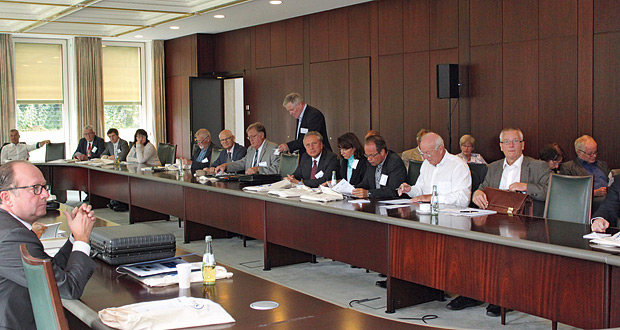Under the title of “Geothermal energy and the search for nuclear repository sites in accordance with the German Repository Site Selection Act”, the 19th Aachen Site Contamination and Mining Subsidence Engineering Colloquium (ABK) was held on 10th July 2018 in the TEMA Pyramid in Aachen/Germany (Figure 1). The conference was organised by the Institute for Mining Surveying, Mining Subsidence Engineering and Geophysics in Mining as well as the teaching and research group for mining, environmental and European law at the RWTH Aachen University and the GDMB Gesell-schaft der Metallurgen und Bergleute e.V. (Society of Metallurgists and Miners), Clausthal-Zellerfeld. After agreeing to phase out nuclear power by 2022, the primary focus is now on impact evaluation and the search for a suitable repository site. The legal regulation implemented by the German Repository Site Selection Act (StandAG), however, is causing authorities and the entire Federal Republic considerable problems. The StandAG was initially created as a special law in 2013 (the 2017 version now applies) with the purpose of finding a safe repository site for nuclear waste in the course of a transparent process, according to the will of the people. The process was reset according to the “white map” principle, which stipulates that no place in Germany is to be considered as eligible or ineligible as a repository site from the outset. The search, however, will be a difficult and particularly lengthy process.
The question was raised as to whether geothermal drilling should take place during this period – including in areas only considered as potential repository sites. Section 21 of the StandAG calls for suitable sites to be secured. But would this result in the complete exclusion of deep geothermal energy? What do the laws say? What would the consequences be? And how can the responsible authorities contribute? These questions and further problems related to the nuclear phase-out and the permanent storage of radioactive waste were discussed at the colloquium in eight interdisciplinary lectures from the perspective of various different experts. This created an overall picture of the nuclear phase-out and its consequences and difficulties.
After a short introduction and greeting from Prof. Axel Preuße of RWTH Aachen, Christian Gosberg from the German Federal Association for Permanent Storage (BGE) opened the conference. As representative of the technical management of the BGE, he spoke about the “Status of the Konrad, Asse and Morsleben repository site projects”. Citing the delay of more than five more years to the planned approval from the Federal Ministry for the Environment, Nature Conservation and Nuclear Safety (BMU) in the case of Konrad, Gosberg explained that some existing agreements no longer align with the General Local Authorities Code and therefore need to be rewritten. He also discussed the detailed testing procedure for each site as well as newly applied exploration technologies and state-of-the-art 3D seismic technology for geoscientific investigation with the objective of minimising costs and economic risks and identifying areas with good chances of success.
This was followed by a presentation from the lawyer Ulrich Wollenteit from Hamburg on “The legal system of site selection”. First, Wollenteit concentrated on clarifying a few fundamental questions: What are we looking for? How do we look for it? Who is responsible for this? Section 1 of the StandAG specifies that the selected site must provide the highest degree of safety for the permanent storage of highly radioactive waste. All opportunities for optimisation must also, therefore, be exploited as part of this search. To answer the question as to how a site is selected, Section 1 Paragraph 2 of the StandAG describes the procedure for finding a site for highly radioactive waste produced within Germany. The procedural principles according to which a site should be selected define the process as participative, scientifically based, transparent, self-scrutinising and adaptive. Wollenteit also made it clear that he thinks the time frame set forth in Section 1 Paragraph 5 of the StandAG whereby a site needs to have been found by 2031 is unrealistic. He also described the phases of the site search as well as the prerequisites, exclusion criteria, minimum requirements and consideration criteria. As for who is responsible, Wollenteit named the main players in the process and discussed new participation formats. Section 5 Paragraph 1 Item 2 of the StandAG expressly names citizens as contributors to the process so as to prevent any possible resistance to a new site.
Hans-Georg Thiem, President of the State Office for Mining, Geology and Raw Materials in Brandenburg, spoke about “Repository sites versus geothermal energy”. To answer the question as to how mining authorities can contribute to the site search, he stated that his office could only provide the BGE with data that it could use for the repository site search. And even this data would be problematic, as it is only collected close to the surface and in profitable regions, the quality of the data is poor and only a limited amount is available in digital format.

Fig. 2. Prof. Walter Frenz during his presentation entitled “The end of geothermal projects? Assigning suitable repository sites versus the need for approval”. // Bild 2. Prof. Walter Frenz bei seinem Vortrag zum Thema „Aus für Geothermieprojekte? Freihaltung geeigneter Endlagerstandorte versus Genehmigungsanspruch“. Photo/Foto: RWTH
Prof. Walter Frenz was next to speak, with a critical argument on the subject of “The end of geothermal projects? Assigning suitable repository sites versus the need for approval” (Figure 2). Frenz discussed the block on projects that could hinder drilling projects and asked whether this block should be permitted despite the fact that until now only one law that supposes a long-term search has come into force and authorities are still being expanded. This would make a block inadmissible in view of the numerous areas that need to be considered. Since the approval requirements set forth in Section 21 Paragraph 2 Item 1 of the StandAG are open to broad interpretation according to Frenz, he focussed on exceptions and minimum requirements as well as hardship cases and the need to broaden basic law.
Werner Grigo from the District Government of Arnsberg discussed “The significance of the law on searching for and selecting a location for a repository site for highly radioactive waste in North Rhine-Westphalia, taking into special consideration the interests of the geothermal energy industry and other sectors of the mining industry”. According to the StandAG, an interim report should be published that lists areas with favourable geological conditions. To do so, the BGE requires data from mining authorities on the geographical situation and the scope of earlier activities in order to be able to apply the exclusion criteria set out by the StandAG to the entire federal territory. In order to protect possible repository sites from the outset, Grigo highlighted the need to find a balance between economic interests and public welfare.
Frank Charlier and Prof. Axel Preuße from the RWTH then gave a presentation on the “Search for a suitable location for final and intermediate storage of highly radioactive waste”. First they described the path to selecting a site as well as the phases in the process, criteria and time requirements. With the amendment to the StandAG, the selection process in future should be carried out on a “scientifically based and transparent” basis.
With his presentation on “Applying the participation model set out in the StandAG to intermediate storage – does the public’s participation in the intermediate storage process need to be fundamentally reformed?”, the lawyer Prof. Tobias Leidinger from Düsseldorf addressed the debate surrounding transparency and legitimation in the selection process. He noted that the participation model set out in the StandAG aims to achieve greater legitimation within society as well as a general consensus with regard to site selection through the participation of citizens. Following a detailed assessment by Leidinger, however, it became clear that the national supervisory committee does not have the necessary technical capabilities, which means that more extensive expertise needs to be injected into this committee for institutionalised public participation.
As the final speaker, Tobias Thienel from Kiel discussed the nuclear power station in Tihange with a focus on “The use of nuclear power beyond borders and its limits” as well as a potential legal ban. According to Thienel, this represents a possible infringement of international and European law by failing to fulfil the commitment to use the best available technology. Since countries that are still in favour of the use of power stations are involved in the drafting of standards, it would be difficult to justify the shutdown of such power stations based on international and European law.
A closing speech from Prof. Frenz concluded the 19th ABK in Aachen, which provided a broad platform for various interests and points of view and was the setting for stimulating discussions. To conclude, Prof. Frenz drew participants’ attention to the 20th KBU on 5th February 2019 entitled “The phase-out of coal: time scale and consequences”. (Schüttler, RWTH)

